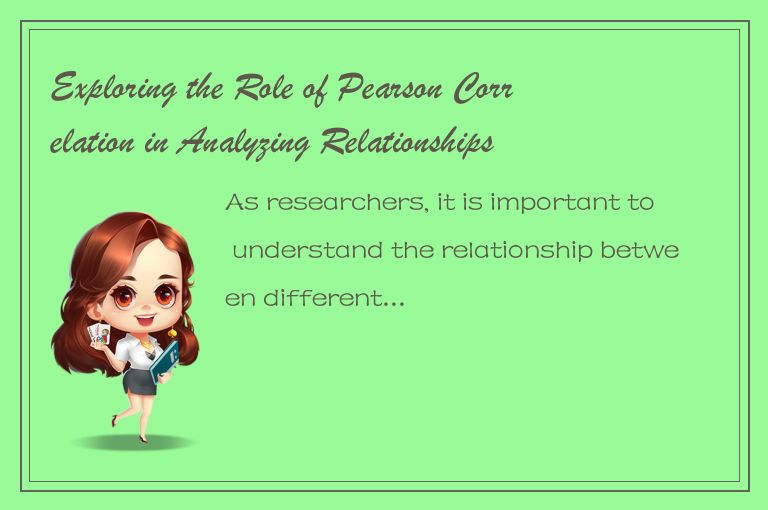As researchers, it is important to understand the relationship between different variables in order to make accurate predictions and informed decisions. One of the most commonly used methods for analyzing this relationship is Pearson correlation, which measures the strength and direction of the linear relationship between two variables.

Pearson correlation is a statistical measure that ranges from -1 to 1, where -1 represents a perfect negative correlation, 0 represents no correlation, and 1 represents a perfect positive correlation. The calculation of Pearson correlation involves dividing the covariance of two variables by the product of their standard deviations.
To better understand the role of Pearson correlation in analyzing relationships between variables, let's consider an example. Suppose we are interested in understanding the relationship between a person's height and their weight. We collect data from 100 individuals and plot their heights and weights on a scatterplot. The resulting plot indicates a positive relationship between height and weight, i.e., as height increases, weight also tends to increase.
Using Pearson correlation, we can calculate the strength of this relationship. Let's assume that the calculated correlation coefficient is 0.85. This suggests a strong positive correlation between height and weight, indicating that individuals who are taller tend to weigh more.
Pearson correlation is widely used in many fields, including psychology, social sciences, biology, and economics. It is particularly useful in studies involving large datasets, where it can help researchers identify relationships between variables that may not be immediately apparent.
However, it is important to keep in mind that Pearson correlation measures only linear relationships. In other words, it assumes that the relationship between two variables is best described by a straight line. If the relationship between variables is non-linear, Pearson correlation may not accurately represent the strength and direction of the relationship.
Another limitation of Pearson correlation is that it measures only the strength and direction of the relationship between two variables, but it does not necessarily imply causation. For example, in our earlier example, although we observed a strong positive correlation between height and weight, we cannot conclude that one variable causes the other.
To determine causality, researchers often need to conduct experimental studies, which involve manipulating one variable and observing its effect on another variable. Correlation does not necessarily indicate causation, and researchers must be cautious in interpreting the results of correlational studies.
In summary, Pearson correlation is a powerful tool for analyzing relationships between variables. It can help researchers understand the strength and direction of linear relationships, and it is particularly useful in studies involving large datasets. However, it is important to keep in mind its limitations, particularly its inability to measure non-linear relationships and its lack of ability to imply causation.
Researchers must carefully consider their research questions and design appropriate studies to gather meaningful data. By using the correct statistical tools and analyzing the data carefully, researchers can draw accurate conclusions and make informed decisions. The role of Pearson correlation is an essential part of this process, and careful consideration must be given to its strengths and limitations in order to use it effectively.




 QQ客服专员
QQ客服专员 电话客服专员
电话客服专员